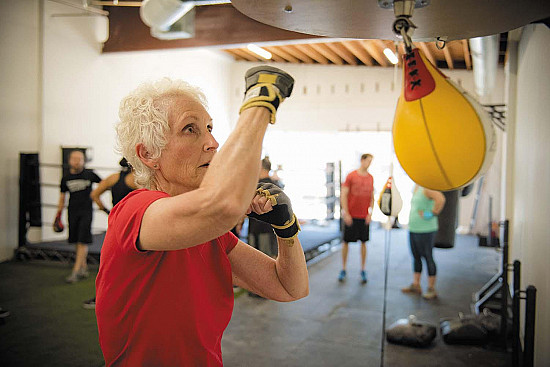Stretching it out
Flexibility can wane with age and a sedentary lifestyle. A regular stretching routine can help you stay limber.
- Reviewed by Howard E. LeWine, MD, Chief Medical Editor, Harvard Health Publishing; Editorial Advisory Board Member, Harvard Health Publishing

Flexibility can be the key that unlocks a safer and more active lifestyle. Proper flexibility means you can bend, reach, twist, stretch, and sit and stand with a greater range of motion and less effort.
Unfortunately, flexibility usually declines with age. Over time, muscles shrink, and tendons lose their water content, which makes your body feel stiffer. Add to this a sedentary lifestyle, and flexibility decreases even more.
The good news is that with a regular stretching routine, you can improve flexibility no matter your age.
"Stretching keeps muscles flexible, strong, and healthy, and you need that flexibility to maintain a healthy range of motion in the joints," says David Nolan, a physical therapist at Harvard-affiliated Massachusetts General Hospital.
Besides improving flexibility, stretching can help reduce exercise soreness and injury risk and improve performance in activities like walking, cycling, and pickleball. Got a nagging pain or tightness? Sometimes a few good stretches can take care of it. Regular stretching also can help people with balance problems avoid falls.
Trouble spots
The trouble spots for most people are the hips, legs, low back, shoulders, and chest. "Of course, everyone is different, and you may have certain areas that are tighter than others," says Nolan.
A physical therapist can assess your muscle strength and tailor a stretching program to fit your needs. If you have chronic conditions like Parkinson's disease or arthritis, you'll want to clear any new stretching regimen with your doctor. "Otherwise, a stretching routine that addresses the main body areas is ideal," says Nolan.
The following is a three-stretch routine to get you started. The stretches come from the Harvard Special Health Report Stretching: 35 stretches to improve flexibility and reduce pain (/str).
For each movement, stretch to the point of mild tension, with no bouncing. "Your stretch should always feel comfortable, so stop if you feel any pain," says Nolan.
Hold each stretch for about 30 seconds. Repeat each stretch two to four times. Perform the routine a few days a week at first, or whenever you feel tight. Eventually, strive toward a daily routine.
"You will get the most benefit from stretching when the muscles are already warm, so consider making time for stretching after exercise or activity," says Nolan. (See "Warming up to stretch.") You also can supplement your stretching routine with yoga, tai chi, or qi gong.
See your doctor or a physical therapist if you experience pain or discomfort while performing these or other stretches, as this could signify an injury or another problem. "Remember that, like any fitness endeavor, stretching takes time and commitment to see and feel results," says Nolan. "Stay with it, and eventually you will reap the benefits."
Warming up to stretchResearch has shown that stretching cold muscles can increase the risk of injury. Take five to 10 minutes before stretching for a dynamic warm-up. Do a fast-paced walk or march in place while swinging your arms. You can also safely stretch after an aerobic or weight-training workout. |
Floor chest stretch
Targets shoulders and chest
Starting position: Lie on your back with your knees bent and feet flat on the floor. Keeping your shoulders down and back, press them against the floor. Place both hands gently behind your head, elbows pointing toward the ceiling.
Movement: Slowly lower your elbows toward the floor to the point of mild tension. Feel the stretch across your chest and in your shoulders and arms. Hold. Return to the starting position.
Single knee rotation
Targets back, hip, and outer thigh
Starting position: Lie on your back with your legs extended on the floor. Relax your shoulders against the floor and extend your arms out to the sides at shoulder level, palms up.
Movement: Bend your left knee and place your left foot on your right thigh just above the knee. Place your right hand on your left knee. Tighten your abdominal muscles, and slowly lower your left knee across your body toward the right wall. Feel the stretch in your low back and hip. Hold. Return to the starting position. Do all repetitions, then switch to the other side.
Calf stretch
Targets calf, Achilles tendon, and ankle
Starting position: Stand up straight. Hold the back of a chair or press your hands against a wall, arms extended at shoulder height.
Movement: Extend your right leg straight back and press the heel against the floor. Allow your left knee to bend while keeping that heel grounded on the floor. Feel the stretch up the back of your lower right leg. Hold. Return to the starting position. Do all repetitions, then repeat with your left leg back.
Image: © © Sasa Djelic/Getty Images
About the Author

Matthew Solan, Executive Editor, Harvard Men's Health Watch
About the Reviewer

Howard E. LeWine, MD, Chief Medical Editor, Harvard Health Publishing; Editorial Advisory Board Member, Harvard Health Publishing
Disclaimer:
As a service to our readers, Harvard Health Publishing provides access to our library of archived content. Please note the date of last review or update on all articles.
No content on this site, regardless of date, should ever be used as a substitute for direct medical advice from your doctor or other qualified clinician.
















